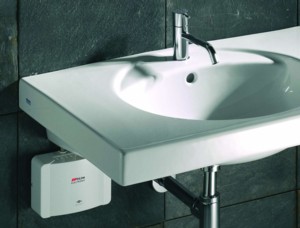Think local

Point-of-use water heaters are evolving and bring a host of benefits, including the use of conventional taps — and with style, as Nick Taylor explains.
Installing an instantaneous water heater enables hot water to be produced close to the point of delivery in locations well away from the boiler or hot water tank, such as shower rooms in extensions or cloakrooms under stairs.
Adding a new cloakroom or shower can often mean that the existing hot-water system would struggle to provide hot water for the extended accommodation. For a relatively small outlay, hot water can be provided on demand instantaneously without the need to replace the existing system. Only a cold-water supply is needed for the new accommodation, and heat losses from running hot water over potentially long distances are avoided.
As domestic fuel prices have climbed dramatically in recent years, system efficiency has become hugely important, as has a growing need to reduce carbon emissions. When not delivering water, instantaneous heaters have zero standing heat loss.
To put standing losses into perspective, consider a commercial organisation where the premises are occupied for 40 hours a week with storage water heaters used to provide water for hand washing. In such an application for the vast majority of the time that the heaters are switched on, the premises are unoccupied. As a result energy savings from using instantaneous water heating instead of storage can typically be over 20%, although actual savings will vary with the demand pattern.
With such strong energy efficiency credentials, one issue that has hindered more widespread adoption of instantaneous water heaters has been their image as the rather unsightly ‘box on the wall’ sitting over sinks or basins. Although doing a good job delivering hot water through an integral spout or spray plate, they have never been at the cutting edge of interior design. With the new generation of in-line appliances, however, all that has changed.
New in-line water heaters are compact and designed to be installed below basins, rather than above, and to deliver hot water through conventional taps. This allows the specifier or home owner the widest possible choice of tap designs. In some commercial settings, spouts fitted to traditional hand-wash units may be vulnerable to vandalism, resulting in loss of use and the added burden of increased maintenance and repair bills. Conventional basin taps are significantly more robust so, whether in a domestic or commercial setting, they are much better able to withstand wear and tear over the years.

The demand for workplace showering is steadily growing, often because of environmental initiatives such as jogging or cycling to work. Instantaneous water heaters are usually the best solution here too, as companies often convert spaces not originally designed to be washroom areas to meet this new demand.
Higher-rated units are required to achieve the flow rates and delivery temperatures required, and purpose-designed electric showers have been sold in volume for many years to answer this need. The latest instantaneous water heaters allow the required temperature to be selected and use state-of-the-art electronic control to ensure it is delivered precisely. For showers, the efficiency advantages of instantaneous water heating over traditional storage water heating can be considerable, especially when the number of draw offs is relatively low. This makes them equally attractive to the commercial building manager as to the home owner.
Using instantaneous appliances will almost certainly result in further savings of both energy and water. This is because storage water heaters are typically situated some distance from the point of delivery and as users wait for the water to run hot, around a third of a litre of water will be wasted for each metre of pipe between the heater and the tap. Up to 43 W/m can also be lost as the hot water is delivered through the pipework, with further energy being lost from hot water remaining in the pipe cooling down after draw-off. As this is per draw off, the net saving made by an instantaneous heater over time can be significant.
Instantaneous water heating is growing in popularity in both commercial and domestic contexts as the energy- and water-saving benefits become more widely known. While there will always be a role for storage water heating, instantaneous offers a number of unique advantages from which specifiers, installers and home owners are increasingly keen to benefit.
Nick Taylor is sales director of Zip Heaters UK







